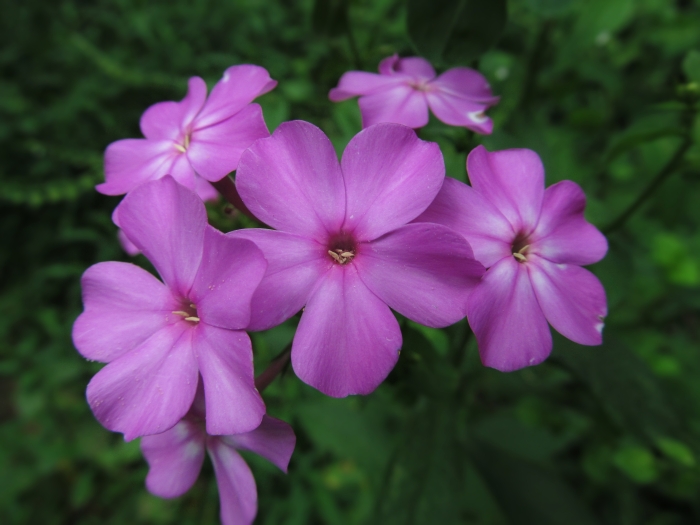Fall Phlox
(Phlox paniculata)
Fall Phlox (Phlox paniculata)
/
/

Cbaile19
CC0
Image By:
Cbaile19
Recorded By:
Copyright:
CC0
Copyright Notice:
Photo by: Cbaile19 | License Type: CC0 | License URL: http://creativecommons.org/publicdomain/zero/1.0/deed.en | Uploader: Cbaile19 | Publisher: Wikimedia Commons | Title: Phlox_paniculata,_2021-08-15,_Seldom_Seen,_04.jpg | Notes: User created page with UploadWizard |

















































































Estimated Native Range
Summary
Phlox paniculata, commonly known as Fall Phlox or Garden Phlox, is a deciduous perennial herb native to open woodlands and fields in the Central and Eastern United States. It typically grows to 120 cm (47 in) tall and 100 cm (39 in) wide, with lance-shaped leaves and erect stems. The plant is renowned for its clusters of showy, fragrant flowers that bloom from mid-summer to early fall. Flower colors in wild populations are predominantly pink, purple, and occasionally white. The blooms are particularly attractive to butterflies and hummingbirds, adding to the plant’s ornamental value.
Garden Phlox is valued for its long flowering period and the vibrant splash of color it brings to borders, cottage gardens, and urban landscapes. It thrives in full sun to partial shade and prefers fertile, moist soil with good drainage. While it is generally easy to maintain, it can be susceptible to powdery mildew, especially in hot and humid conditions. To prevent this, ensure good air circulation around the plants and practice proper watering techniques. Garden Phlox can be propagated through division, root cuttings in autumn, or basal cuttings in spring, and it makes an excellent choice for cut flower arrangements.CC BY-SA 4.0
Garden Phlox is valued for its long flowering period and the vibrant splash of color it brings to borders, cottage gardens, and urban landscapes. It thrives in full sun to partial shade and prefers fertile, moist soil with good drainage. While it is generally easy to maintain, it can be susceptible to powdery mildew, especially in hot and humid conditions. To prevent this, ensure good air circulation around the plants and practice proper watering techniques. Garden Phlox can be propagated through division, root cuttings in autumn, or basal cuttings in spring, and it makes an excellent choice for cut flower arrangements.CC BY-SA 4.0
Plant Description
- Plant Type: Herb
- Height: 2-4 feet
- Width: 2-3 feet
- Growth Rate: Moderate
- Flower Color: Pink, Purple, Red, White
- Flowering Season: Summer, Fall
- Leaf Retention: Deciduous
Growth Requirements
- Sun: Full Sun, Part Shade
- Water: Medium
- Drainage: Fast, Medium, Slow
Common Uses
Bee Garden, Bird Garden, Border Plant, Butterfly Garden, Deer Resistant, Fragrant, Hummingbird Garden, Low Maintenance, Showy Flowers
Natural Habitat
native to open woodlands and fields in the Central and Eastern United States
Other Names
Common Names: Garden Phlox , Panicled Phlox , Perennial Phlox , Summer Phlox , Perennial-Pink , Phlox , Fall-Pink , Sweet-William , Have-Floks , Stauden-Phlox
Scientific Names: Phlox paniculata , Phlox decussata , Phlox canescens , Phlox acuminata , Phlox undulata , Phlox omniflora , Phlox brevifolia , Phlox brownii , Phlox clarkioides , Phlox cordata
GBIF Accepted Name: Phlox paniculata L.